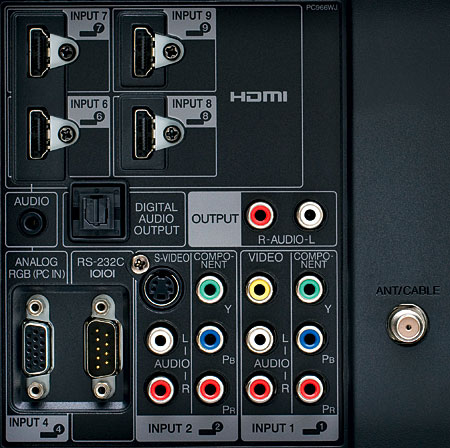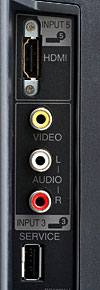Sharp Aquos LC-46D85U LCD HDTV Page 2
Post calibration, the Sharp’s color was hard to fault and was visually equal to the best I’ve seen from an HDTV. The overall color palette is appealing, but more importantly, it offers particularly good fleshtones and believable greens. Details are also crisply defined, and the set produces a solid illusion of depth with most HD programming.

Even with the Full Motion Enhanced feature off, as described earlier, motion lag never bothered me. Are plasma and DLP sets somewhat better in this respect? Yes. But I had no complaints. The only times I saw banding or false contouring—another annoyance on many modern digital sets—were when it appeared to originate in the source. There were some non-uniformity issues in large areas of gray or solid color, but I usually had to look hard to see them on normal program material.
The Santa Clause 3: The Escape Clause (Blu-ray) is hardly the best film in Disney’s profitable Christmas franchise, but it’s a high-definition eyeful. The bold color palette and vivid details that fill Santa’s workshop are an open invitation to sensory overload, but the Sharp’s excellent resolution and precise color made perfect sense of it all. While I wish I could say the same of the movie itself, the eye candy alone kept me watching.
Get Smart (Blu-ray) was a very different experience. It’s filmed in a relatively straightforward style and looks exceptionally natural throughout. The color and detail may not be as eye-popping or in your face as they are on The Santa Clause 3, but the Sharp rarely took a wrong step. The scenes shot in Moscow’s Red Square looked particularly striking.
 Grayness Falls
Grayness Falls
If the two films above have anything in common, it’s their brightly lit (for the most part) cinematography. But a few dark scenes in Get Smart hinted at the Sharp’s two primary weaknesses: black level and shadow detail.
The Sharp is below average in these areas, even among the more reasonably priced LCD sets we’ve reviewed. It handles bright scenes exceptionally well. And even slightly dim scenes can work if they include sufficient bright highlights to distract the eye from the set’s less than inky blacks. But genuinely dark scenes don’t come off well. I could definitely follow the action as Indy and Mutt prowl around at night at an archeological site in chapter 6 of Indiana Jones and the Kingdom of the Crystal Skull (Blu-ray). But it was hard to ignore the distracting grayness on its dimly lit shots.
The set’s Active Contrast feature was little or no help. While it did lower the black level significantly, it also crushed the dark grays to the point where I had to increase the Brightness control in order to re-establish a proper setup. The result was little or no net benefit. In many scenes, Active Contrast added a trace of unnatural harshness to the image as well.
It was no surprise that the Sharp’s image deteriorates significantly even at relatively small off-axis viewing angles. This is a common flaw in LCD sets. The happiest Sharp owners will be single viewers—or very close couples. For the observations in this review, I viewed the Sharp from dead center.
Comparisons and Conclusion
Fortunately, I still had a fully calibrated Sony BRAVIA KDL-46XBR8 LCD on hand (HT, January 2009).
I stacked it up in a side-by-side comparison with the Sharp and fed the same material to both sets. This latest Sony flagship design has LED backlighting and local dimming. In theory, this combination should improve color. In practice, it definitely improves both black level and shadow detail.
On medium to bright scenes, the Sharp and Sony produced astonishingly similar performance. Despite the Sony’s slightly better measured color, most viewers would likely be hard-pressed to choose a favorite, even with the Sony’s more cutting-edge LED backlighting. The biggest color differences were a more orangey red and a marginally warmer tone from the Sharp.
It was also difficult or impossible to declare a winner with respect to sharpness and detail.
But on dark scenes, the Sony showed the Sharp the door. Of course, it was a very expensive door. Local dimming sets can cost two or (in the case of the Sony) up to three times the price of their less sophisticated LCD cousins. Are they worth it? Yes, they are—if you can spare the cash without going on a year-long binge of mac-and-cheese dinners. (Sharp has just introduced its own local dimming sets—the Limited Edition series—which are also extraordinarily expensive.)
If you’re looking for an LCD set that will let you subsist on a more varied diet, the Sharp LC-46D85U is a tasty candidate. It’s not perfect, but no set is, particularly at this price.
If you like the secure feeling that comes from dealing with a manufacturer with a long, solid reputation in the LCD field, this might just be your next set. It’s definitely worth a close look.





























































